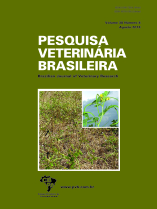 |
|
|
|
Year 2018 - Volume 38, Number 8
|

|
Influence of polypyrrole and salinity levels on biofilm formation in Aeromonas spp, 38(8):1528-1536
|
ABSTRACT.- Pires I.C., Freire N.B., Fernandes A.W.C., Souza R.F.S., Silva Jr F.A.G., Oliveira H.P. & Costa M.M. 2018. [Influence of polypyrrole and salinity levels on biofilm formation in Aeromonas spp.]. Influência do polipirrol e dos níveis de salinidade na formação de biofilme em Aeromonas spp. Pesquisa Veterinária Brasileira 38(8):1528-1536. Laboratório de Microbiologia e Imunologia Animal, Universidade Federal do Vale do São Francisco, Rodovia BR-407 Km 12, Lote 543, Projeto de Irrigação Nilo Coelho, C1, Petrolina, PE 56300-000, Brazil. E-mail: isabellecpires@hotmail.com
Bacteria of the genus Aeromonas are highly disseminated pathogens in the aquatic environment, responsible for great economic losses in the pisciculture of several countries. They are opportunistic microorganisms and their pathogenicity is linked to some virulence factors, such as biofilm formation. Saline stress is one of the factors that favor the formation of these colonies and, consequently, the increase of infections. These infections, when associated with biofilm, are even more resistant to antimicrobials. In this context, polypyrrole stands out as an antimicrobial alternative because it has several therapeutic attributes and does not present toxicity to organisms. Thus, the objective of this study was to evaluate the susceptibility profile and the biofilm formation capacity of Aeromonas spp. associated with different levels of salinity and polypyrrole. The antibacterial activity of the isolates was determined and motility assays were performed with bacteria bearing the fla gene. The ability of sodium chloride and polypyrrole to interfere with biofilm formation has also been demonstrated. The results were evidenced with scanning electron microscopy. Concentrations of 2 and 3% of NaCl inhibited bacterial motility. In the biofilm formation, 83% of the bacterial isolates induced production at the concentration of 0.25%. Polypyrrole caused the death of all the isolates tested at the concentration of 125μg/mL. In addition, this compound decreased bacterial motility at concentrations of 0.25 to 3%, and no biofilm was produced. These results show that the different levels of NaCl influence in the formation of the biofilm favoring the persistence of the infection. This study also highlighted the potential of polypyrrole as a bactericidal agent, being an effective alternative to antimicrobial drugs for the treatment of infections caused by Aeromonas spp. |
| |
|
|
| |
|
 |